Regardless of your goal, whether you want to increase conversions or build brand awareness, integrated marketing communications campaigns are effective because you’re essentially presenting a unified message across different channels. Instead of relying on one marketing channel, you’re leveraging several channels to tap into a wider audience.
And because you’re reiterating the same message on multiple channels, this increases the likelihood of visitors seeing your brand and message multiple times, thus putting your business front and center.
- What Is Integrated Marketing Communications?
- Components of Integrated Marketing Communications
- Key Benefits of Integrated Marketing Communications
- Developing an Integrated Marketing Communications Strategy
- How to Measure and Evaluate the Effectiveness of Integrated Marketing Communications
- Examples of Companies Deploying Integrated Marketing Communications
- Conclusion
- Frequently Asked Questions
What Is Integrated Marketing Communications?
Integrated marketing communications (IMC) is a concept and process that enables brands to create consistent messaging across all channels. As a strategy, it entails creating unified experiences for your customers by eliminating disparities in your marketing efforts and campaigns.
By creating unified, seamless experiences across all your marketing channels, including both traditional media and digital marketing channels, you’re making it easier for your audience to understand what your brand’s primary message is.
IMC has been around for decades and was introduced in the 1980s-1990s by Medill professor emeritus-in-service Don Schultz, when modern forms of communication began to emerge as a result of technological developments like computer technology and the growing use of computers. These developments enabled companies to gather data, giving them insights into effective marketing tactics, consumer behaviors, and campaign performance.
Components of Integrated Marketing Communications
Creating an integrated marketing communications strategy or campaign can be a complex endeavor. It combines different elements, such as advertising, sales promotion, and internet marketing, to create an omnichannel approach. To effectively create an IMC strategy or campaign, here are some key components to keep in mind:
A unified message
This is perhaps the most important component of IMC. To ensure your brand is communicating a clear, cohesive, and consistent message across all channels, the departments working on the campaign must have an in-depth understanding of what you’re trying to convey.
A data-driven strategy
IMC relies on data. Therefore, you need to leverage it to create a clear and structured IMC strategy. Some of the important datasets you want to collect and analyze include engagement (impressions and clicks), demographics, and behaviors. Having a good understanding of your audience and using data allows you to create bespoke campaigns.
Defined leadership roles
Because you’re working with different departments, it’s important to have leaders who will oversee each campaign and ensure that all activities contribute to creating a cohesive and consistent campaign. These leaders are also responsible for making timeline decisions and monitoring the campaign budget. More importantly, leaders help ensure that your IMC strategy aligns with your brand and the promise it’s communicating to your customers, your audience and their expectations, and your budget goals.
Key Benefits of Integrated Marketing Communications
Having an integrated marketing strategy gives you a competitive edge. It also lets you create more customer-centric omnichannel experiences. By allowing you to create and deliver a consistent brand message, IMC campaigns help promote brand recognition, gain your audience’s trust, and shape consumer perception around your brand.
Below are IMC’s other key benefits:
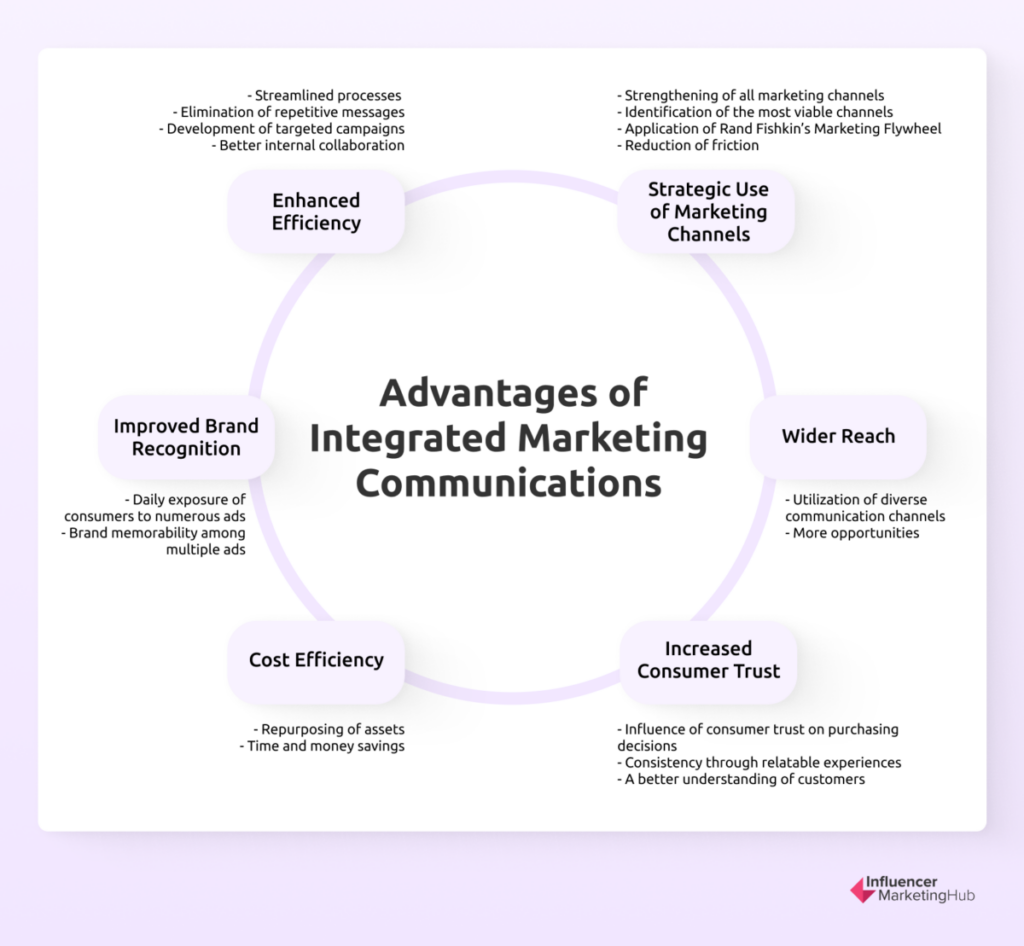
Enhanced Efficiency
Implementing an IMC strategy helps you streamline your processes, as well as your internal assets and communications. It also helps you avoid spending time developing and promoting repetitive or conflicting messages. This means you can create more targeted campaigns that align with your larger business objectives. Furthermore, it promotes better internal collaboration across different departments, from marketing to customer service.
More Strategic Use of Marketing Channels
Implementing an IMC strategy can help you strengthen all your other marketing channels and determine which channels are more viable or effective to use. Looking at Rand Fishkin’s Marketing Flywheel, you can leverage repeatable and strategic actions that are scalable, as each tactic can help reduce friction in the later stages.
Wider Reach
Using different communication channels lets you widen your reach. Moreover, implementing an IMC strategy gives you more opportunities to reach and attract the right audience segment for your brand. However, the key is to remain consistent with your targeting and primary brand message across all the channels you’re using.
Increased Consumer Trust
Consumer trust is one of the key factors that influence a customer’s purchasing decisions. When a brand delivers experiences that don’t meet the promises they made, 65% of consumers are likely to switch brand loyalties.
Consistency across all your marketing helps build consumer trust because you’re giving your customers a relatable experience at every touchpoint. If you deliver inconsistent brand messages, which leads to disjointed brand experiences, it can imply that you don’t have a granular-level understanding of your customers. And it’s highly likely that your audience won’t trust your brand.
Cost Efficiency
Instead of distributing your content and tailoring it for a specific channel, an IMC strategy lets you save time and money by letting you adopt the same primary brand message across all your marketing channels. You can also repurpose your assets so that you can use them for all your other marketing channels.
Improved Brand Recognition
People see anywhere between a handful to hundreds of ads daily. In a sea of ads, it can be difficult to remember each and every brand a customer comes across. Creating a unified, recognizable message across all channels is an effective approach to enhancing your brand’s memorability and helps with brand-building.
Developing an Integrated Marketing Communications Strategy
Understanding IMC allows you to tailor your marketing efforts so you can tap into its multiple benefits and get better results. Below are actionable tips to help you create your own IMC strategy.
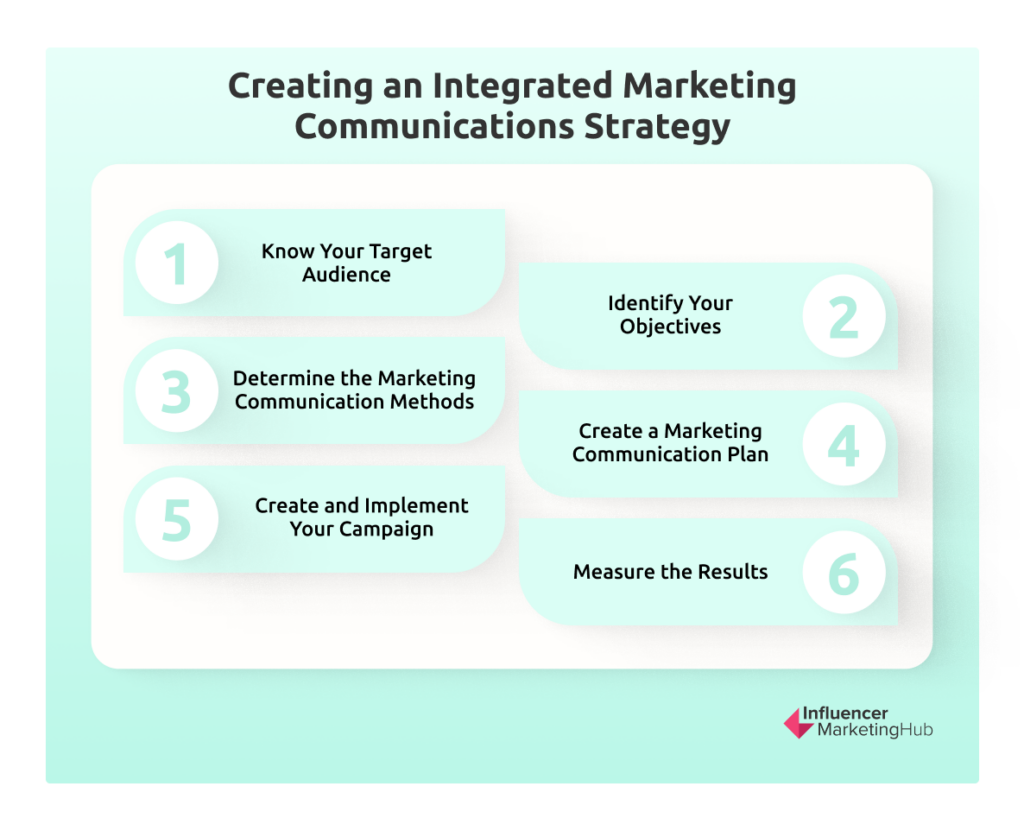
Know Your Target Audience
The first step to developing an IMC strategy is determining who your target audience is. You’ll need to consider factors like their demographics, behaviors, preferences, and interests. You need to get an in-depth understanding of your customers to create a targeted customer profile for a given campaign. Doing so helps you create a bespoke strategy for your communications plan.
Identify Your Objectives
Knowing why you want to implement an integrated marketing communications strategy helps you successfully implement it. You can start by outlining a general objective and then narrowing it down into SMART marketing goals.
For example, you may want to boost sales by XYZ% for each quarter or you may want to increase subscriptions by XYZ within a six-month period. At this stage, it’s also important to start identifying the KPIs you want to use to measure your performance. In addition to knowing your objectives, you’ll need to know what your unique selling proposition (UPS) is.
Your UPS highlights what sets your brand or products apart from the competition. Your UPS is also an important factor in building your brand identity and helps you communicate the value you can offer to your target audience.
Determine the Marketing Communication Methods You’ll Be Using
Knowing the most effective communication methods to use starts with you knowing more about your audience. This means knowing how they like to receive information and what approaches or channels they use for research. Some of these channels include content marketing, advertising, PR, and social media marketing. For each marketing channel, you’ll need to identify specific goals.
Create a Marketing Communication Plan
Once you’ve laid the groundwork for your IMC strategy, you can start developing a comprehensive marketing communication plan. For this, you’ll need to focus on three key aspects:
- Your audience – Create a separate buyer persona for each marketing method. For example, if your primary target audience is Millennials and Gen Zs, consider using social media channels like Instagram and TikTok to engage with them.
- Your content – Identify the type of content that resonates with and is relevant to your target audience. For example, if you want to convert your leads into paying customers, you can provide them with high-quality and helpful resources like guides, video content, and case studies, coupled with compelling calls to action.
- Frequency – An effective IMC strategy also depends on frequency. This means you need to deliver the right content at the right time to the right audience. However, you don’t want to bombard your target audience with too much information. To avoid this, you can use marketing automation platforms that will help you determine how and when people engage with your brand and content on all your channels.
Because you’ll be having different teams working on each campaign, you’ll need to make sure that all of them are in sync. This means coordinating and monitoring efforts to ensure that not only are your campaigns and messages consistent, but also that each team understands your brand and what you’re trying to convey.
You can do this by organizing meetings and providing your team with platforms to facilitate better, real-time communication.
Create and Implement Your Campaign
Doing your research and creating a marketing communication plan helps you determine which channels to focus on, how much you’re going to spend for a specific campaign, what the competition is doing, and how you can tailor your content for a particular marketing channel. At this point, it’s important that you’ve already set up your budget plan, which should align with your overall budget for marketing.
Once you’ve done all of these, you can implement your IMC plan. To deploy it more effectively, use a content calendar to organize your content schedule and assets. You may also want to consider using automation software to optimize and speed up your workflow.
Measure the Results
Provided that you’ve already identified your KPIs, you can start measuring the effectiveness of your IMC strategy. For example, you may use split testing to see which vehicles or channels are successful and which ones need to be improved.
The work doesn’t stop with measuring the results of your campaign. You’ll need to continuously analyze and revise your strategy so you’re better equipped to respond to changing market conditions and consumer behaviors and expectations. You can start by evaluating each marketing channel to determine if they’re still effective or you can identify emerging trends that you can incorporate into your IMC strategy.
How to Measure and Evaluate the Effectiveness of Integrated Marketing Communications
Determining your KPIs allows you to measure the effectiveness of your IMC campaigns. One of the KPIs you need to pay attention to is your marketing ROI. This tells you if your efforts are giving you effective results or not. Other KPIs and metrics you can use are as follows:
- Reach – This includes impressions, repeat visits, and confirmed reach.
- Engagement – Engagement metrics include the number of followers, positive and negative sentiments, the number of shares, and the number of comments on each social media post or content.
- Email marketing metrics – Metrics include bounce rate, click-through rate (CTR), and open rate for emails.
- Paid media metrics – Paid media metrics include cost per click, click-through rate, cost per impression, and customer acquisition costs.
- Sales – Sales metrics include lead to MQL and number of purchases.
- Website metrics – Some key metrics to consider when measuring the effectiveness of your marketing efforts include average time per visit, bounce rate, visits per page, number of sessions, and total sessions.
Examples of Companies Deploying Integrated Marketing Communications
How do different companies leverage integrated marketing communications? Here are some examples of IMC in practice.
Sephora
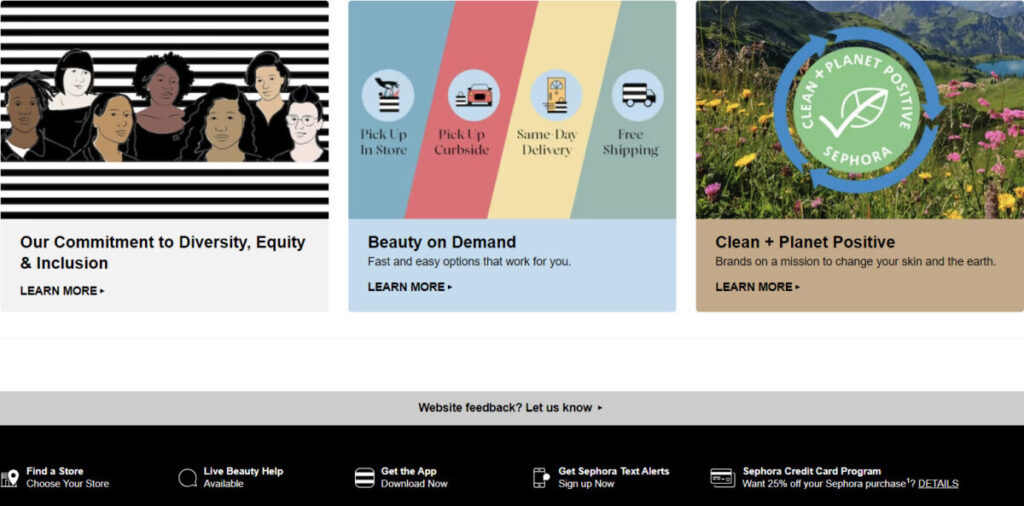
Source: sephora.com
Sephora knows how to leverage its brand codes, which are distinctive assets that make it easier for your audience to recognize and recall your brand. It uses brand codes, such as its distinct black-and-white color palette, consistently across its physical stores and digital channels. For example, its shopping bags and store interiors use the same black and white stripes. Its website also uses the same color palette and styling for its blog thumbnails and footer text.
Cisco
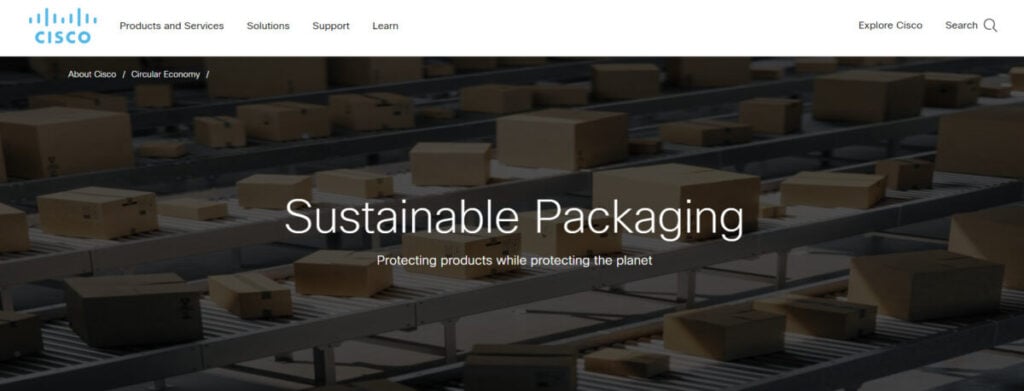
Source: cisco.com
Cisco used an integrated marketing communications strategy to improve its social customer relations. The strategy utilized data from different social channels to engage with customers and listen to what they were saying. As a result, it created a campaign that integrated customer communications into the company’s overall strategy. This led to increased positive sentiment while allowing the company to address customer concerns over harmful product packaging.
Always
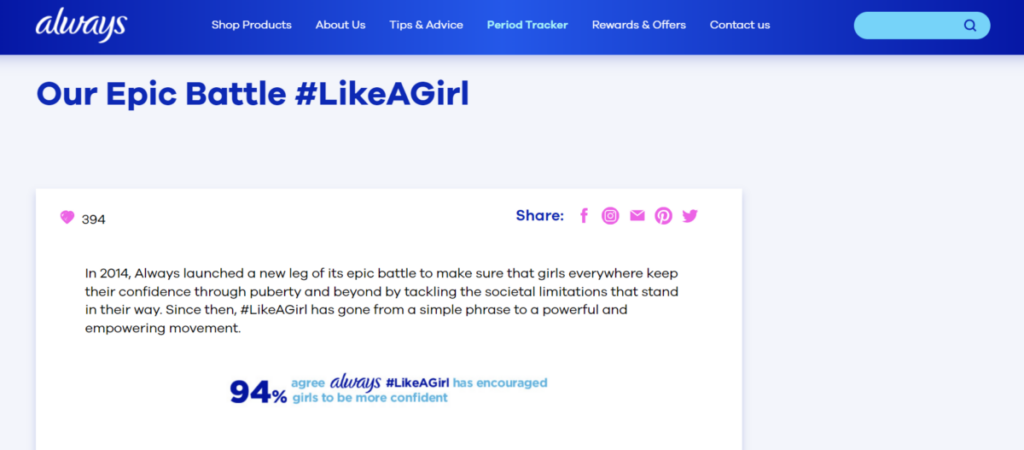
Source: always.com
Always’ 2014 #LikeAGirl campaign utilized an integrated marketing communications strategy, transforming the derogatory phrase into something empowering. The campaign utilized consumer data and market research to get a better understanding of girls’ self-esteem and what the usual first touchpoint with the company was for their target audience.
Aside from using traditional media channels like TV and print, #LikeAGirl also leveraged social media and created a campaign video that gained recognition. The campaign was instrumental in changing perspectives and raising global awareness of the struggles of girls going through puberty.
Conclusion
Implementing an integrated marketing communications strategy can be complex. However, when done properly, it can contribute to your business’s growth. By conveying a unified message across all your marketing and communications channels, you’re better equipped to reach out to a wider audience, build brand awareness, and gain customer trust.
The great thing about IMC campaigns is that they’re scalable and measurable, allowing you to determine if a campaign is effective or reaching the right audience. More importantly, IMC allows you to stay on top of consumer expectations and behaviors by leveraging data, helping you craft relevant campaigns or messaging tailored specifically for them.
Frequently Asked Questions
Why is integrated marketing communications important?
Aside from boosting your revenue, integrated marketing communications can help you expand your reach and tap into a larger audience, build brand awareness and trust while minimizing costs, and maintain a good relationship with your existing customers. It also helps you save time when it comes to determining the best marketing tools to use for your campaigns.
Where can I use integrated marketing communications?
Integrated marketing communications is a versatile process that can be applied to unify your different marketing communication efforts (traditional and new media) for public relations, social media, advertising, promotions, corporate communications, and more.
How do I create a budget for integrated marketing communications?
Having a large budget allows you to operate on a larger scale and have a broader reach. However, not all companies can allocate bigger budgets for IMC efforts. According to Niosi et al. (2020), to develop an IMC campaign budget, you’ll need to determine your total available budget for a campaign. Outline the methods and tools you’ll be using for the said campaign, and determine the budget you’ll allocate for each method or tool. You can use budgeting approaches like top-down budgeting, bottom-up budgeting, or the objective-task method to determine your budget for IMC campaigns.
What are some of the challenges of IMC?
One of the biggest challenges in deploying IMC is communication and collaboration. That’s because you’ll need to combine different teams, budgets, and goals. Another obstacle to successful IMC efforts is the implementation itself. You’ll need clear documentation and coordinated efforts across different teams and channels.


